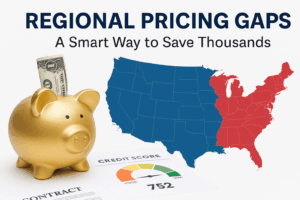Most car buyers know what they want. Fewer know when to buy. Timing your purchase is not just about catching a sale. It is about understanding how inventory pressure, regional pricing, and behavioral fit converge to create leverage. This guide breaks down a smarter, data-driven way to time your car purchase without relying on guesswork or generic seasonal advice.
Why Timing Is a Strategic Lever
Dealerships operate on cycles. Inventory flows in, incentives shift, and managers face quarterly targets. That means the same vehicle can be priced differently depending on when you walk in. The timing of your purchase affects not just the sticker price but also your financing terms, insurance premiums, and resale value.
Instead of waiting for a holiday sale or hoping for a flash deal, smart buyers use timing as a tactical advantage. They track inventory age, incentive cycles, and regional pricing gaps to identify the moment when negotiation power shifts in their favor.
Start with Inventory Age, Not Just Availability
Most buyers search for availability. They ask if the car they want is in stock. But the real question is how long it has been sitting there. A vehicle that has been on the lot for 60 days or more is costing the dealer money. That pressure builds toward the end of the quarter when sales managers need to hit volume bonuses.
Use VIN-based tools to check how long a specific unit has been listed. If it is aged inventory, you are in a stronger position to negotiate. If it is fresh stock, expect less flexibility. Timing your visit around inventory pressure is one of the simplest ways to gain leverage.
Watch for Incentive Cycles and Dealer Behavior
Manufacturer incentives such as cashback, low APR, and lease specials follow predictable cycles. They often reset at the beginning of the month, spike near quarter-end, and taper off during inventory transitions. But what matters more is how dealers respond.
Some dealers pass incentives directly to buyers. Others bury them in bundled pricing. The key is to compare listings across regions. If one dealer is offering a $2,000 cashback and another is not, you have found a leverage point.
Also watch for certified pre-owned flash sales. These often signal dealer urgency, especially when paired with aggressive financing terms or bundled warranties.
Align Your Purchase with Regional Pricing Gaps
Regional pricing gaps are real. A car listed in a high-demand urban area might be $1,500 more than the same model in a nearby suburb. Dealers adjust pricing based on local competition, inventory pressure, and seasonal demand.
Use multi-region listing tools to compare prices across ZIP codes. Then layer in seasonal timing. Convertibles spike in spring, all-wheel-drive vehicles rise in winter. If you are flexible, buy out-of-season and out-of-region. That is where the margin lives.
Use Behavioral Fit to Filter Out Noise
Not every deal is a good deal for you. Behavioral fit means matching the car’s features, usage profile, and ownership costs to your actual lifestyle. It is not just about the sticker price.
For example, a discounted SUV might look appealing. But if your commute is short and your parking is tight, the long-term costs will outweigh the upfront savings. Timing your purchase also means timing your decision logic. Filter out noise and focus on vehicles that match your behavioral profile.
Understand the Impact of Depreciation on Timing
Depreciation is not just a long-term concern. It affects your purchase timing. A vehicle that is about to roll into a new model year will drop in value faster, even if it is brand new. That affects your loan-to-value ratio, your insurance premiums, and your resale window.
Smart buyers align their purchase with the tail end of a model cycle, when dealers are clearing out inventory but before the depreciation curve steepens. This creates a better fit for short-term loans, lease buyouts, or resale planning. It also helps avoid overpaying for a vehicle that will lose value rapidly in the first year.
Leverage End-of-Quarter Dealer Pressure
Dealers operate on quarterly cycles. The last two weeks of March, June, September, and December are prime windows for negotiation. Sales managers are under pressure to hit volume bonuses, clear aged inventory, and lock in manufacturer incentives.
If you walk in with data on inventory age, regional pricing, and incentive cycles, you are not just browsing. You are negotiating from strength. Timing your purchase around dealer pressure is one of the most effective ways to reduce your total cost.
Guesswork is expensive. Timing your car purchase is not about luck. It is about layering behavioral fit, inventory pressure, regional pricing, and incentive cycles into a strategy that works for your budget and lifestyle.




